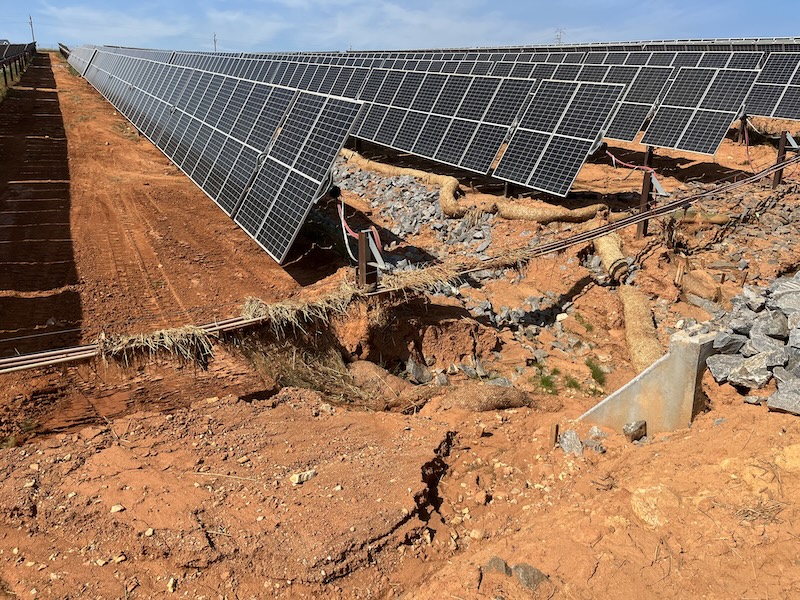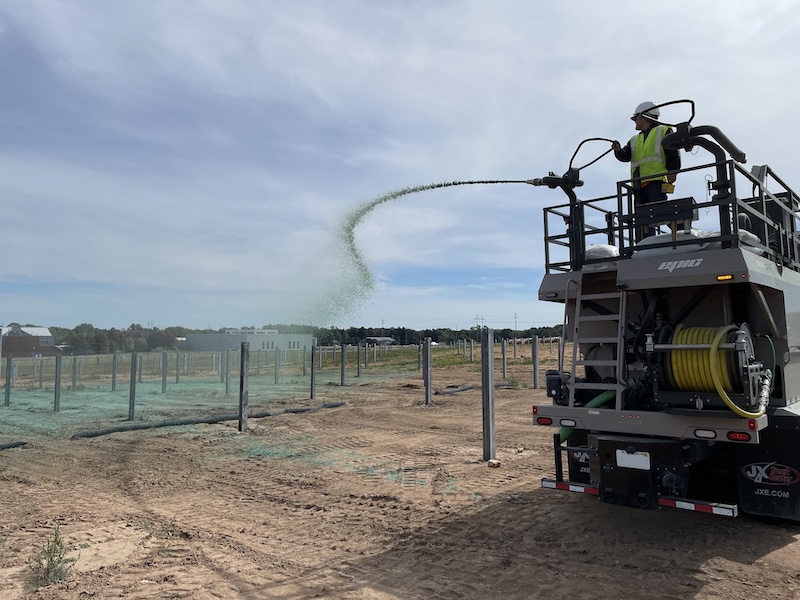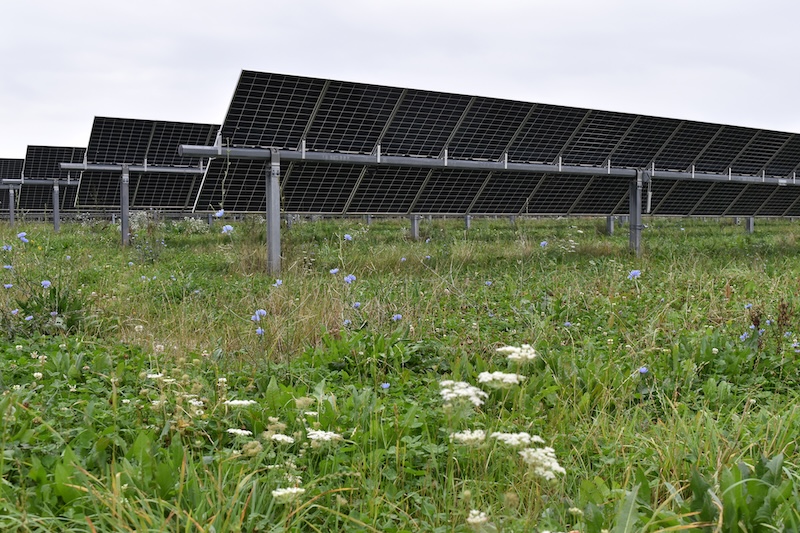Safeguarding Solar Success: Erosion control strategies for utility-scale projects
Utility-scale solar sites promise clean energy, but their success can depend on tackling an often-overlooked challenge: soil erosion. For one 20 MW solar project in Michigan, the stakes were clear. Excessive rain washed away seeded vegetation multiple times, which exposed sensitive infrastructure and forced costly reseeding efforts. These hurdles serve as a reminder that preventing erosion is essential for the success of solar developments.
The site’s eventual success relied on a prescriptive approach, employing innovative erosion control measures to stabilize the site and promote sustainable vegetation. As research shows, the risks that plagued this project aren’t uncommon. Across the U.S., many utility-scale solar sites face similar situations. To navigate these challenges effectively, developers must prioritize soil health and erosion concerns from the outset, integrating site-specific insights and advanced solutions into their planning.
Initial attempts to vegetate the site failed after seed washed away from heavy rains
Challenges at the Michigan site
Prior to creating and implementing a thorough erosion control plan, the project manager faced a few challenges. The first attempts at growing vegetation failed after rain events repeatedly washed away seed. The site development process had left depleted soil conditions, resulting in unsuccessful initial attempts to establish vegetation. Because the site is located near impaired waterways, it was imperative to resolve these issues to prevent runoff or face additional challenges and regulatory pressure.
Additionally, according to local news reports, community members voiced concerns that the solar site would negatively impact the land and surrounding environment. This further emphasized the need to find an effective and environmentally friendly solution that would build trust within the community. If possible, the solution needed to provide a benefit to the surrounding community.
Hydromulching allowed contractors to easily apply an erosion control product across the solar site (image courtesy of Profile Products)
With construction nearing its end, the project manager needed to stabilize and establish a permanent stand of vegetation to begin the energy generation phase. Recognizing the need for a targeted approach, the project manager worked with an erosion control contractor on a plan. The contractor chose to employ an advanced best management practice called hydromulching, an environmentally friendly technique that sprays a slurry mixture of hydraulically applied erosion control products (HECPs), seed, fertilizer, soil amendments and water over large areas. This practice prevents soil erosion while promoting rapid vegetation growth to stabilize the soil in an efficient and sustainable manner.
A high-performing flexible growth medium product was installed, designed for soil stabilization and promoting early establishment of vegetation. Its unique composition allowed for immediate surface protection, shielding seed from washout and encouraging healthy vegetation growth. With the community’s sustainability concerns in mind, the team chose to use a pollinator-friendly vegetation mix that would benefit the ecosystem and local agricultural land long-term.
Within weeks, the results were transformative. Vegetation began to thrive for the first time, stabilizing the site and eliminating turbid runoff. Not long after, the project owner received approvals for the energy generation phase. The site was energized, and renewable energy began production. Two years later, the vegetation continues to protect against erosion and provide long-term ecological benefits. The inclusion of a pollinator-friendly vegetation mix addressed community concerns about sustainability, fostering goodwill and supporting local agriculture. Estimates report more than 170 agricultural acres in the vicinity of the project benefitted from this solution.
Follow-up inspections show the site thriving with lush pollinator-friendly vegetation (image courtesy of MacBeth Solar)
Lessons learned
The challenges at this and similar sites across the nation highlight the need for data analysis to predict risks and implement proactive measures early in the planning process. The prevalence and significance of erosion risks at utility-scale solar sites have underscored the urgent need for more advanced analytics.
This need for more data led one research team to develop a model that could analyze more than a dozen geospatial factors to determine soil erosion risk. After researching more than 13,900 current and potential solar project sites nationwide, the results were staggering: the data showed nearly one-third of U.S. solar sites — more than 294,000 acres — face moderate to high erosion risk on significant parts of these projects. This stems from factors such as precipitation, soil erodibility and slope gradation, all of which can amplify erosion potential.
With all the considerations that go into developing a solar site, it may not seem like the erosion risk could cause significant issues. But that line of thinking couldn’t be further from the truth. If left unaddressed, it can lead to larger problems in four interconnected areas:
- Regulatory compliance: Erosion and sediment runoff can lead to environmental regulation violations, such as the Clean Water Act. Without effective erosion control, sediment laden runoff risks contaminating local water bodies, which could trigger fines and delays.
- Environmental impact: Unchecked erosion degrades soil health, reduces biodiversity and increases sedimentation in nearby ecosystems.
- Financial costs: Delays from erosion issues can escalate costs through repeated reseeding, infrastructure repair and compliance-related fines.
- Community perception: Visible erosion and its environmental consequences can harm relationships with local communities.
 Making sense of the data
Making sense of the data
Looking retrospectively at the Michigan project, it’s clear why initial attempts at establishing vegetation failed. A comprehensive evaluation of the site identified several risk conditions, based upon soil type, slope length and gradient, and climatic factors. Additionally, predicted changes in precipitation patterns revealed a potential 24.5 percent increase in severity and/or frequency of precipitation events. The Revised Universal Soil Loss Equation (RUSLE2) forecasted a high predicted soil loss rate and resulted in an Erosion Risk score approximately 20 percent higher than the averages for solar sites around the state. These factors contributed to the sites rating of “high risk” for erosion and vegetation establishment issues.
It's also clear why the HECP solution proved to be a successful one. The primary advantage of hydroseeding is its ability to establish sustainable vegetation quickly. As vegetation grows, its root systems bind the soil and prevent it from washing away. The HECP acts as a protective layer, reducing the impact of rainfall and sheet flow and shielding the soil from further degradation. This solution directly combatted the challenges of significant precipitation and soil loss highlighted by the data. Had this data been available at the time, it’s possible the project manager would have been able to create a prescriptive approach during the project’s initial design.
As this case study proves, the challenges facing solar development sites today underscore how erosion risk analysis is not an optional consideration for developers, but rather a prime component of project success. As the clean energy sector continues to expand, embracing these strategies will be essential for building infrastructure that is resilient, sustainable and welcomed by the communities it serves.
Stephen Macshane is a market development manager at Profile Products, which operates Solar Solutions to establish ideal vegetation that meets industry regulations, community restrictions and solar design parameters. Stephen can be reached at [email protected].
Profile Solar Solutions | profilesolarsolutions.com
Author: Steve Macshane, CESSWI
Volume: 2025 July/August












.jpg?r=1381)


